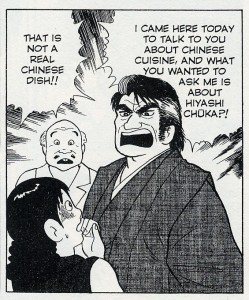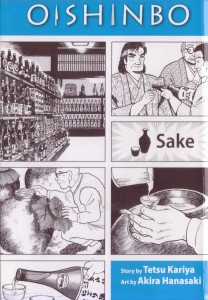I am a foodie. You rolled your eyes just now, didn’t you? I don’t blame you. Everyone is claiming to be a “foodie” these days, from your brother-in-law who just discovered white truffle oil (Gordon Ramsay says that’s sooo last year….) to your Mom who found an ethnic restaurant in town with dishes whose names she can’t pronounce. (“Mom, it says ‘salad’.”)
I am not the kind of foodie that drifts from one trendy flavor to another (seriously, mangosteen is over) at all. I’m the kind of foodie who loves food. I mean, I just like to eat. Think less Ted Allen, more Homer Simpson.
It is often said offhandedly that there is “manga for everyone,” but until recently, that was largely not true in English. There was manga for everyone if by “everyone” you meant everyone 12-18 years old or so. Now that the manga bubble has burst, manga publishers, searching for an audience that actually has money to spend on books – and prefers books to downloads – have stumbled on the niche adult manga market. Which means we’re actually getting manga these days more suited to adult tastes. Today we’re talking four food and drink manga that can help train your mind and palate and give you an instant one-upsmanship with your non-manga-reading foodie friends. Welcome to Pretentious Gittery in Food and Drink the Manga Way.
 Oishinbo has the be the first course. Any rube can tell you that they taste the difference between regular California short-grain rice and Koshihikari rice grown and imported from Japan, but Oishinbo will help you to discuss the difference in the more pretentious terms. Was the storage area dry enough? Where was the water used for cooking from?
Oishinbo has the be the first course. Any rube can tell you that they taste the difference between regular California short-grain rice and Koshihikari rice grown and imported from Japan, but Oishinbo will help you to discuss the difference in the more pretentious terms. Was the storage area dry enough? Where was the water used for cooking from?
Wrapped in an equally entertaining and annoying tale about rival newspapers and rival father and son food experts, Oishinbo in Japan was begun in 1983, and is now up to 104 collected volumes. Written by Tetsu Kariya, with art by Akira Hanasaki, Oishinbo is not a cooking manga. It is a food manga. It is about the experience of eating food, and often covers the subtle differences that husbandry, farming, storage, shipping and preparation can have on that experience. In America, a few select chapters have been collected into an ala carte’ selection, focused around specific food areas. Sushi and Sashimi, Rice, Gyoza and Ramen, Sake, Traditional Japanese cuisine, Vegetables, Pub Food…each volume picks and chooses from chapters published over the last 30 years. By the end of the American volumes, you’re sorely tempted to go out and try ramen at your favorite local place, just to complain about the use of food coloring and MSG.
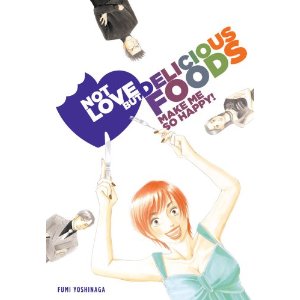 If you find the tone of one-upsmanship too harsh in Oishinbo, then try a more feminine touch with Not Love, But Delicious Foods Makes Me So Happy by Fumi Yoshinaga. Yoshinaga presents this foodalogue as an amusingly insulting candid autobiography of her life and the food she eats. Where Hanasaki’s art has improved over the last 30 years, Yoshinaga’s art starts at levels far exceeding anything you’ll see in Oishinbo. The people are drawn both beautifully (and less so,) but the food is always gorgeous. Her relationships with the people in her life are organized by their ability to appreciate food. Of all the books on food and drink that I have read, this one most closely approximates my own foodie existence. Yoshinaga’s take on food is approachable, but her focus on texture and mingling of flavors are both things that Americans particularly, are bad at and so, become an accessible first step into pretentious gittery.
If you find the tone of one-upsmanship too harsh in Oishinbo, then try a more feminine touch with Not Love, But Delicious Foods Makes Me So Happy by Fumi Yoshinaga. Yoshinaga presents this foodalogue as an amusingly insulting candid autobiography of her life and the food she eats. Where Hanasaki’s art has improved over the last 30 years, Yoshinaga’s art starts at levels far exceeding anything you’ll see in Oishinbo. The people are drawn both beautifully (and less so,) but the food is always gorgeous. Her relationships with the people in her life are organized by their ability to appreciate food. Of all the books on food and drink that I have read, this one most closely approximates my own foodie existence. Yoshinaga’s take on food is approachable, but her focus on texture and mingling of flavors are both things that Americans particularly, are bad at and so, become an accessible first step into pretentious gittery.
The inevitable next step after reading Not Love is to hop on over to Yelp and start reviewing your favorite restaurants. Don’t forget to discuss the Bolognese sauce at your favorite Italian restaurant as “authentic” even if you’ve never been to Italy, much less Bologna.
Now that you’ve taken your first steps into being a pretentious git about food, it’s time to get ready for the big guns of pretentious gittery – Wine.
Is there any area of food or drink that has such a well-established pedigree for encouraging pretentious gittery as wine? Perhaps, but even those who don’t know anything about food or drink shudder at the thought of being seated with a person who “knows a lot about wine.”
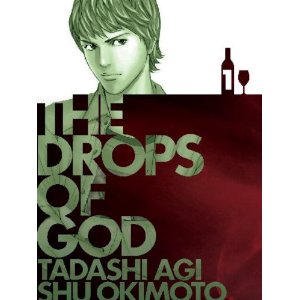 Tadashi Agi’s Drops of God has been so influential in forming, educating and influencing the Asian wine market that long before it was translated into English, this manga had articles written about it in the Wall St. Journal and the New York Times. In fact, so grown up and pretentious is this series, that the New York Times actually deigned to allow this manga on their “Graphic Novels Worthy of Being Gifts” List this year.
Tadashi Agi’s Drops of God has been so influential in forming, educating and influencing the Asian wine market that long before it was translated into English, this manga had articles written about it in the Wall St. Journal and the New York Times. In fact, so grown up and pretentious is this series, that the New York Times actually deigned to allow this manga on their “Graphic Novels Worthy of Being Gifts” List this year.
Once again wrapped in a story about a rivalry, and a quest for the greatest wines on earth, Drops of God allows the audience to learn the importance of decanting, about village wines, terroir and other things that no one else at the table cares about, really, as long as the wine tastes good. If your family member or friend actually does know a thing or two about wine, don’t expect to impress them with this manga. They already know this stuff and are unlikely to be moved by a comic book. More importantly, the manga itself addresses the pressure that wine snobbery places on everyday people and provides a brilliant tip to glean the credit while knowing nothing. If you’re not a wine drinker, this manga will be a hard read. Everyone eats food…not everyone drinks wine. But if you’re starting to get into wine and can taste the difference between a Merlot and a Cabernet, or a family member or friend is in that space, this is a good way to bump up pretension to expertise in a fun way.
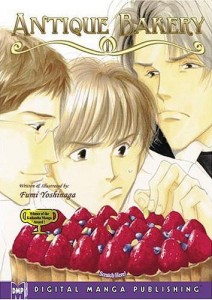 Last, after all of our food and drink, we turn to dessert, and back once again to Fumi Yoshinaga with Antique Bakery. Unlike the rest of the manga here, the pretentious gittery in Antique Bakery is not the actual story, it is merely decoration on the plate. Nonetheless, if you can’t stand to not be a git about the cream used in your choux à la crème (or, shu cream, if your pretentious gittery leans toward Japan, rather than France,) this manga makes a perfect ending to your meal.
Last, after all of our food and drink, we turn to dessert, and back once again to Fumi Yoshinaga with Antique Bakery. Unlike the rest of the manga here, the pretentious gittery in Antique Bakery is not the actual story, it is merely decoration on the plate. Nonetheless, if you can’t stand to not be a git about the cream used in your choux à la crème (or, shu cream, if your pretentious gittery leans toward Japan, rather than France,) this manga makes a perfect ending to your meal.
The goal here today is not to bore your friends and family (although that outcome is probably inevitable) but to indulge your brain along with your tastebuds.
To end, I want to share with you a real story about pretentious gittery.
I was at someone’s house and they poured me a glass of wine that, they said, had a distinct scent of tobacco and traces of mushroom. I took a sip and said, “You’re right, it smells like an old man bar and tastes like a moldy basement.”
I may never become a good pretentious git about wine, but I’m great at being a pretentious git about manga. ^_^ These manga are perfect for the inner pretentious git in you.

